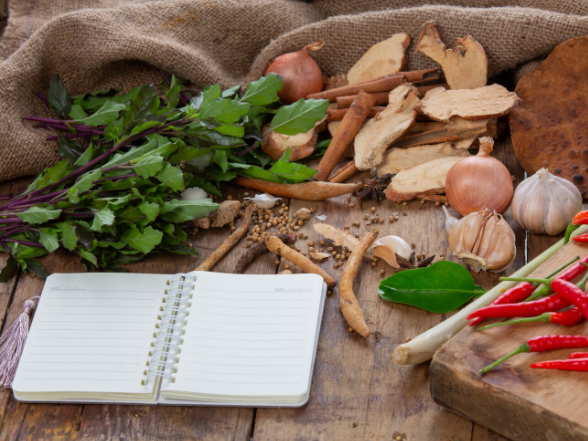In Korean cuisine, herbs are not only flavor enhancers — they are also powerful sources of healing and wellness. For centuries, Korean culinary herbs have served a dual role: adding depth to dishes and supporting the body’s natural balance. Even today, as modern hospitals and nutritionists emphasize holistic health, these herbs remain central to Korea’s food culture and traditional medicine.
Korean people have long believed that “food is medicine” (약식동원, yak-sik dong-won), meaning the food we eat daily can prevent disease. As more scientific studies confirm the benefits of traditional herbs, modern chefs and doctors alike are embracing these natural ingredients for both flavor and healing power.
The Healing Wisdom of Korean Herbs
Unlike synthetic supplements, Korean herbs work gently with the body. They are rich in antioxidants, vitamins, and natural compounds that help strengthen immunity, improve digestion, and calm the mind. Today, herbs once found only in Hanbang clinics or countryside kitchens are appearing in trendy restaurants, wellness cafes, and even hospital menus. Let’s explore some of the most beloved Korean culinary herbs with proven medicinal benefits.
● Perilla Leaf (깻잎, Kkaennip)
A staple in Korean dining, perilla leaves are often used for wrapping rice, meat, or kimchi. Their slightly minty, nutty taste also carries strong health benefits.
- Rich in omega-3 fatty acids, which help reduce inflammation and support heart health.
- Contains rosemary acid, an antioxidant known for reducing allergies and improving skin conditions.
- Aids digestion and detoxification, helping the liver process fats and toxins.
- Its antibacterial properties help preserve food and prevent spoilage.
Tip: Add fresh perilla leaves to grilled dishes or use them in tea to relieve indigestion.
● Ginseng (인삼, Insam)
Perhaps the most famous of all Korean herbs, ginseng is often considered a symbol of vitality and longevity.
- Boosts energy and mental focus, often used to fight fatigue.
- Enhances immune system strength and improves overall stamina.
- Helps regulate blood sugar and blood pressure.
- Contains ginsenosides, which support brain health and reduce inflammation.
Tip: Enjoy ginseng in tea, chicken soup (samgyetang), or desserts like ginseng honey tea for a gentle daily tonic.
● Garlic (마늘, Maneul)
Used in nearly every Korean dish, garlic is both a flavor base and a medicinal powerhouse.
- Strongly antibacterial and antiviral, helping the body fight infections.
- Reduces bad cholesterol (LDL) and improves blood circulation.
- Boosts the immune system, especially during flu season.
- Helps regulate blood sugar and protects the liver.
Tip: For maximum benefits, use raw or lightly cooked garlic in sauces, kimchi, and marinades.
● Ginger (생강, Saenggang)
Warm and aromatic, ginger is widely used in Korean soups, teas, and marinades.
- Excellent for digestive health, reducing nausea and bloating.
- Acts as a natural anti-inflammatory for joint and muscle pain.
- Improves circulation and warms the body during cold weather.
- Enhances metabolism and relieves menstrual discomfort.
Tip: Drink warm ginger tea with honey to relieve colds or sore throats — a classic Korean home remedy.
● Green Onion (파, Pa)
Green onions, found in nearly every Korean kitchen, do far more than add flavor to soups and pancakes.
- Contains allicin, which fights bacteria and boosts immunity.
- Reduces nasal congestion and cold symptoms.
- Helps detoxify the body and support cardiovascular health.
Tip: A bowl of pa-guk (green onion soup) is often eaten after drinking alcohol to help the liver recover.
● Korean Mint (방아잎, Bangah-ip)
A refreshing herb often used in rural dishes and temple food, Korean mint has a delicate, aromatic flavor.
- Aids digestion and relieves bloating.
- Helps cool the body and calm heat-related symptoms.
- Improves appetite and reduces nausea.
Tip: Add fresh Korean mint to salads, pancakes, or herbal tea to promote relaxation.
● Chrysanthemum Leaves (쑥갓, Ssukgat)
Common in hot pots and stews, chrysanthemum leaves have a slightly bitter but refreshing taste.
- Rich in vitamin C and beta-carotene, supporting skin health and immunity.
- Known to reduce inflammation and stress.
- Helps lower blood pressure and support heart health.
Tip: Blanch lightly and serve as a side dish (namul) or add to hotpot for a fragrant, nutrient-rich touch.
● Mugwort (쑥, Ssuk)
Mugwort has been a treasured herb in Korean medicine for centuries. Used in both food and moxibustion therapy, it’s known as a woman’s herb due to its benefits for reproductive health.
- Promotes circulation and detoxification.
- Regulates menstrual cycles and relieves cramps.
- Boosts immunity and warms the body’s core.
- Has natural antibacterial and anti-inflammatory effects.
Tip: Enjoy mugwort in rice cakes (ssuk-tteok), porridge, or tea for gentle body cleansing.
● Wild Sesame (들깨, Deulkkae)
Wild sesame seeds and leaves are rich in nutrients and often used to make creamy sauces or soups.
- Packed with calcium and magnesium, which strengthen bones.
- Rich in omega-6 and omega-9 fatty acids, promoting heart health.
- Contains antioxidants that slow aging and improve skin elasticity.
Tip: Sprinkle ground wild sesame seeds into stews or mix them with vegetables for a nutty, nutritious side dish.
Modern Science Confirms Ancient Wisdom
Recent research by the Korea Food Research Institute (KFRI) and several universities confirms the scientific basis of traditional herbal uses.
● Studies show that ginseng extract improves mental alertness and immune response.
● Perilla oil is linked to reduced cholesterol and inflammation markers.
● Mugwort and garlic have demonstrated antibacterial activity in clinical trials.
● Chrysanthemum tea helps lower oxidative stress in the bloodstream.
These findings reinforce that Korean herbs are not just culinary traditions — they are evidence-based natural medicines.
Tips for Using Korean Herbs in Daily Life
● Add variety: Mix herbs in small amounts daily instead of large doses occasionally.
● Use fresh, local ingredients: Fresh herbs retain more active compounds.
● Pair with balanced meals: Combine herbs with protein, grains, and vegetables for harmony.
● Avoid overuse: Even natural herbs can cause side effects when overconsumed.
● Drink herbal teas regularly: Gentle infusions of ginger, perilla, or mugwort keep your system balanced.
The Future of Herbal Cuisine in Korea
As wellness becomes a lifestyle, modern Korean restaurants and hospitals are collaborating to design menus that blend nutrition, taste, and traditional wisdom. Chefs are creating herb-infused sauces, healing teas, and low-sodium herbal broths, while hospitals incorporate herbal diets into recovery plans. In wellness cafés across Seoul, you’ll now find drinks like perilla leaf smoothies, mugwort lattes, and ginseng honey tonics, appealing to both locals and tourists seeking natural health boosts.
Final Thoughts
Korean culinary herbs are more than cooking ingredients — they are living medicine that nurture body and spirit. From ginseng’s vitality to perilla’s heart-protective oils, these herbs continue to shape a food culture built on wellness and balance.
● Eat with purpose — let your food heal you.
● Rediscover ancient flavors with modern science.
● In Korea, every meal is a path to better health.
The harmony of flavor and healing defines Korean cuisine — reminding us that good health begins not in the pharmacy, but in the kitchen.













